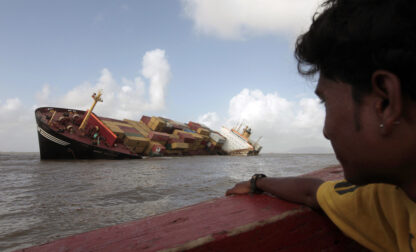Some areas most devastated by Hurricane Helene were the most remote, making those stories the hardest to tell. But that didn’t deter multiformat AP journalists committed to letting the world know what happened in southern Appalachia.
Multiple AP teams overcame myriad logistical challenges and adeptly managed scarce supplies to deliver heart-breaking stories of the destruction wrought by Helene on mountain communities. Just getting a signal to transmit material required climbing hills or walking around until staff found hot spots at churches or fire stations. AP journalists drove hours in and out of the storm zone each day so as not to strain scarce lodging for locals and work crews and all the staff involved had to navigate different road closures, communications difficulties and safety concerns on a daily basis.
Symbolic of that effort, AP was first to use the dateline of Chimney Rock, rumored to have been wiped off the map. After navigating closures and rugged forest roads, chief photographer Mike Stewart, and video journalists Erik Verduzco and Allen G. Breed talked their way in. Stewart chatted with troopers at a checkpoint and let them use his Starlink to send text messages to spouses — since even exhausted authorities had limited ways to communicate from the devastated location. The kind touch paid off, and Stewart and Breed were escorted in, while Verduzco interviewed survivors just outside. The Chimney Rock feat was confirmed later that day when photo journalists at several outlets called Stewart to ask him how he’d gotten in — their journalists had been trying. Even as the AP crew was finishing up at the scene, they saw authorities turn other journalists away.
The next day, Stewart and reporter Jeff Amy carefully traversed damaged roads to be among the first journalists to reach remote Pensacola, North Carolina, where rescuers were using ATVs to reach mountain ridgetops. Meanwhile, video journalist Brittany Peterson and reporter Jeffrey Collins followed tips and used their beat experience to tell human stories in Asheville, Hendersonville and Augusta, Georgia. Photographer Jeff Roberson used his keen eye and experience to find iconic shots in hard-hit Hot Springs and Marshall. Makiya Seminera, Chris Carlson and Leah Willingham found stories of people struggling in Boone, Vilas and Erwin, Tennessee. Remotely, a cross-department operation was convened each day to support the journalists, get their all-formats material out quickly and polish thematic sidebars, including John Seewer remotely working to make the prose sing in daily mainbars.
Resourcefulness also played a role in competitive performance. Many outlets wanted to tell the story of the damage to two key mountain mines that produce the purest quartz in the world, but few had fresh photos. Reporter Gary Robertson made fresh pictures of the mines while embedded on an aerial tour of the mountains with the governor to allow AP to illustrate the story. Peterson’s smart idea to cover the return of Asheville’s well-known downtown drum circle meant that AP appeared to be the only outlet to document the digitally friendly and hopeful story about a small slice of resilience and joy among the tragedy.
The judges were impressed by the tenacity of the teams, which allowed them to access areas devastated by Helene to tell incredible stories of tragedy, resilience and recovery.
For overcoming endless hurdles and extraordinary resourcefulness, the nominees earn this week’s Best of the AP — First Winner.
Visit AP.org to request a trial subscription to AP’s video, photo and text services.
For breaking news, visit apnews.com.





